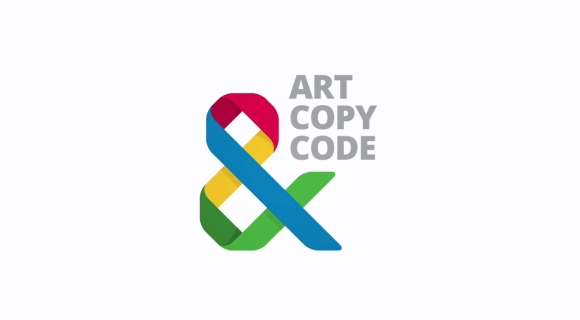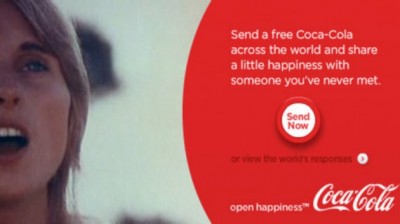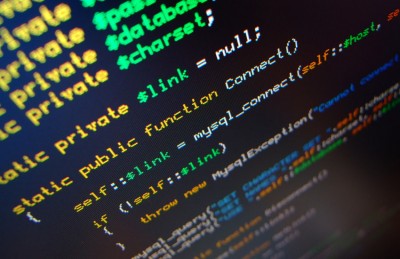Today, we round out our month-long series on visual communications hearing from Mike Glaser who is part of Google’s latest technologically-advanced advertising venture – Art, Copy & Code. Designed by Google’s Creative Partnerships team, these advertising professionals have taken a big leap into the future of visual communications and are fueling a creative revolution right before our eyes by exploring the marriage of design, messaging and – you guessed it – technology.

Credit: Google
Upon visiting the Art, Copy & Code website, a promotional video launches showing clips tailored to your location, time of day, and current headlines. In an effort to leverage the massive amounts of data collected through the internet, Art, Copy & Code demonstrates the propensity for increasingly targeted advertising campaigns. For this latest advertising initiative Google has partnered with companies that share their vision to power new forms of brand expression through engagement. Burberry’s Kisses campaign and Volkswagon’s Smiledrive campaign are among the advertising campaigns being developed. Art, Copy & Code aides these companies in creating campaigns that allow their consumers to interact with and share their favorite brands.
Today, Mike shares with us how Art, Copy & Code is changing the future of storytelling through dynamic videos and is supporting brands to create new innovation and maintain a strong and unique presence today and into the future. Along the way they are showcasing the best practices for using code with brands and advertising. We welcome their insights.
– – –

Credit: Google
Google’s first technologically-advanced advertising series, Project Re: Brief, launched last year. What is the goal of this project and how did this project get off the ground?
Project Re: Brief was an experiment that we launched in 2012 to re-imagine what advertising could be, and to push the boundaries of how technology and creative ideas could work hand in hand. In it, we re-imagined four iconic ads for the digital age–Coca-Cola’s “Hilltop,” Volvo’s “Drive It Like You Hate It,” Avis’s “We Try Harder,” and Alka-Seltzer’s “I Can’t Believe I Ate The Whole Thing.” We did this in partnership with the legendary creatives who made these campaigns in 60’s and 70’s. We also captured the process behind the magic in a feature length documentary, directed by Emmy-award winning director Doug Pray.
A year later, what inspired Google to develop the Art, Copy & Code series? What differentiates the two series?
Our Art, Copy & Code initiative evolved out of Project Re: Brief. We wanted to push the creative boundaries further, in partnership with advertisers and agencies. Fundamentally, Art, Copy & Code is still about exploring the role of technology and creativity working side-by-side, but comes to life on live creative briefs instead of iconic campaigns from decades past.

Credit: Camlin Technologies
Please explain how code is becoming integral to the branding and design process?
Historically, branding and design has been led by a core team skilled in art direction and copywriting. We believe that the new creative team involves a third member–the coder, engineer, or creative technologist–who is every bit as creative but fundamentally expresses ideas through a different medium. The pairing of those three disciplines–art, copy and code–is helping forward thinking brands and agencies unlock new creative and storytelling ideas that were never before possible.
We’ve watched the Art, Copy & Code film on a few of our office computers only a few feet apart and seen different clips. Can you explain how the film makes selections as to what we view?
The Art, Copy & Code film is context-aware, meaning that it updates every time the viewer presses play, using signals like time of day, location, and weather to customize the creative. In it, we see other elements like real-time news feeds from leading creative websites, as well as prominent creative professionals and their recent work. With this, we’re hinting at the future of storytelling through video, and the possibilities therein when we leverage the power of dynamic video content.
Google has partnered with some big name brands as part of Art, Copy & Code. How and why were these brands chosen?
These projects are a pivotal part of Google’s broader efforts to partner more deeply with creative agencies and brand marketers, as they look to create experiences that consumers love, remember and share. We’re committed to investing in tools over the long term to help brands and their agencies succeed not just today, but in a future that will look very different. For this project, we were looking for opportunities associated with a few specific technology and creative trends we’re observing. And so, to do this, we partnered with several global brands known for innovative marketing (and those who share our vision). Of course, every collaboration between Google and brands and agencies is an opportunity to innovate.

The Burberry Kisses campaign. (Credit: Burberry)
Code engages the public and allows us to participate in campaigns where traditionally we had only been spectators. What are some examples of how the public is able to participate in the stories Google and its partner brands are creating through Art, Copy and Code?
Last year, we partnered with Burberry to launch Burberry Kisses, a program that invites users to capture a kiss by using their computers webcam, or by actually kissing the screen of their smartphone. The user can then dress that kiss up in a Burberry lipstick color, and send it to a friend by using Google+, Google Maps, and Chrome. The aggregate story of all the users in the world sending kisses is then told on Burberry’s website. In many ways, it’s the actual public participation that truly brings Burberry’s campaign to life.
What are some best practices for using code with brands and advertising?
We believe that technology works best when it seamlessly operates in the background; when it fuels new creative ideas and brand experiences in an easy and user-friendly manner. To arrive at these ideas, we like to involve technologists at the very start of every project, as we’ve learned that they can help unlock new ideas–new forms of storytelling on the web.
What kind of feedback have Project Re: Brief and Art, Copy & Code generated? What’s ahead for Google’s re-imagination of advertising?
Feedback has been overwhelmingly positive so far, and we’re looking forward to releasing a new set of projects, in partnership with new and exciting brands and agencies, in the coming months. We want to find creative applications from all fields of computer science, and the list is growing every day. Please stay tuned!
– – –
Our interdisciplinary team of communication professionals, graphic designers, and internet junkies were excited to learn more about the future of advertising. Many thanks to Mike for his insights.
What advertising campaigns do you think could benefit from combining the power of art, copy, and code?
The Collaborative Services Blog Team

Recent Comments